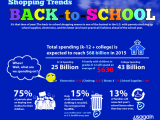Giving your Back-to-School preparations an eco-friendly twist can make the end of summer more exciting as you set up for a successful year that is organized by efficiency!
We all know this time - cherished since we were old enough to load up our backpacks with Lisa Frank folders and those brightly-colored smelly markers. Fall is around the corner and the back-to-school butterflies begin to fill our stomachs. We busy ourselves by loading up on stuff - and more stuff - to supposedly help us organize and simplify for the coming year.
All this new stuff requires natural resources (e.g., trees, water, and energy) from mother earth and that is certainly something we all know doesn’t grow on trees and not to forget financial resources from your own bank account. The back-to-school flood of consumption towards new clothing, notebooks, and other essentials adds up.
This year about 55 million students will attend school from elementary to high school and approximately 20 million students will be enrolled in higher education. Ethical Ocean estimates that about 75% of parents plan on sending their children to school in new clothes. Ethical Ocean also notes that 35-45% of solid waste comes from institutions like businesses and schools.
You don’t have to be a mathematical ace to do the calculation. There’s a lot of opportunity to reduce waste and save money while gearing up for the back-to-school haul.
Here are 4 easy eco-friendly tips to change the way you do back-to-school:
1.) REUSE.
In the alphabet of sustainability, we’ve learned that “R” comes before “R.”
(What the what?) We’ll explain.
Recycling. It’s an always and ever important step in reducing waste streams, but it should be a last resort. The beginning of a new year is an ideal time to determine what can be reused from last year. Binders can be reused with minor repairs. Notebooks that still have blank pages can be used. Pens and pencils from last year can carry over. Paper that’s only been used on one side can serve as scratch paper. Even backpacks can be repaired. If you do have to buy a new one, consider supporting a company that offers repairs like one of favorite environmentally friendly businesses, Patagonia.
2.) SHOP SMART
Bring your brain to the store with you and a carefully prepared shopping list. Shopping in a rush or stressful state of mind might end in wrong choices and more money. This is when the reduce word comes in. And another one: resist the urge to impulse buy. Know exactly what you need and conduct a digital audit. Is there anything you can do electronically, rather than with paper? Start early, plan well and enjoy the experience. According to Staples’ recent survey of 1,006 parents 81% said they get all their child’s school supplies by the first day of school so their child’s prepared to succeed right from the start.
3.) RECYCLE
Think outside of the recycling bin! Recycling has moved on up over the past years and has graduated from something we could participate in only after we were finished with a product. From pencils to papers, you can start the cycle by buying items made with recycled content.
What’s more, you can help contribute to recycled supplies. Recycling is no longer limited to papers and plastics. You can recycle electronic goods and even textiles - including clothing and shoes. When you clean out last year’s clothes that have been outgrown, it’s easy to give them a second life through textile recycling programs like those from USAgain. Click here to find a textile deposit bin near you.
4.) MAKE A YEAR-LONG PLAN
Don’t stop right where you started. Eco-friendly habits can upgrade your entire year with cost and time savings. Lunch, for instance, is a great opportunity to pack smart. You can buy in bulk and make your own snack-sized packs at home. Don’t forget to pack lunches in sustainable materials. (Ditch the disposables by investing in reusable wear!) You can also incorporate more alternatives within daily transportation. Try mixing things up with walking, biking, and mass transit when available. Lastly, take good care of your things. Have a safe place to store important essentials so that they last longer and to prevent them from being lost.
If you’re committed to making a difference by practicing the “three Rs” of waste reduction this school year, connect with us on Facebook for more ideas and to keep the conversation going!
